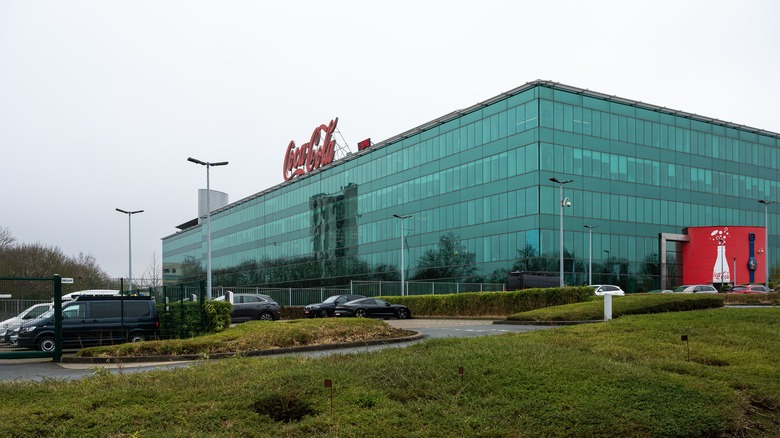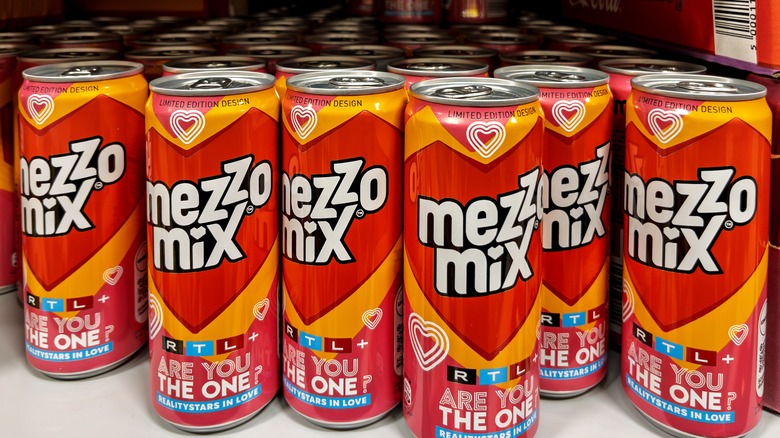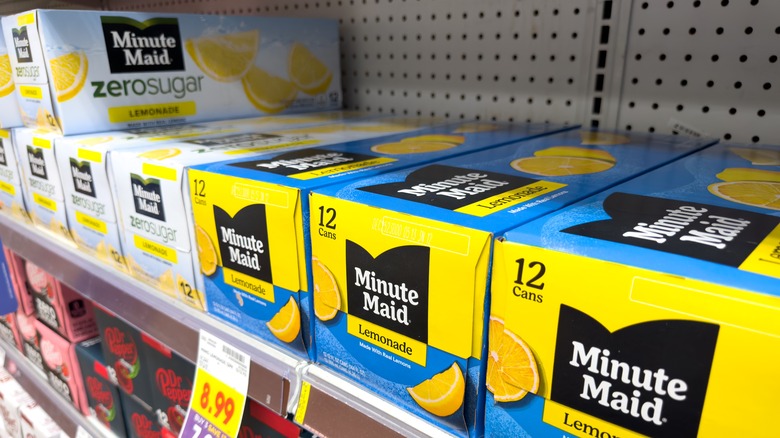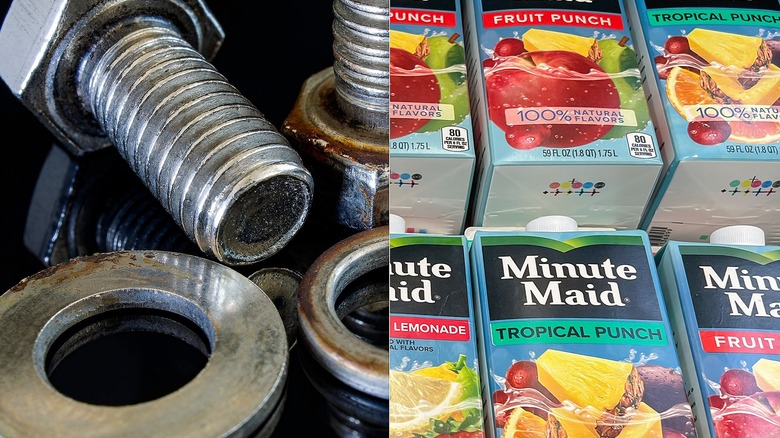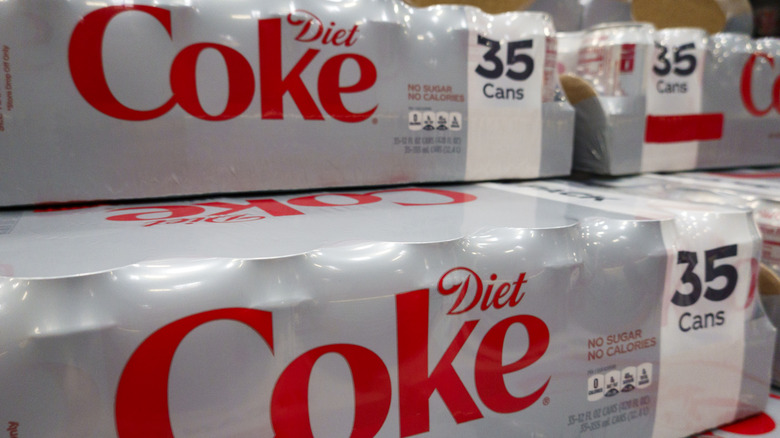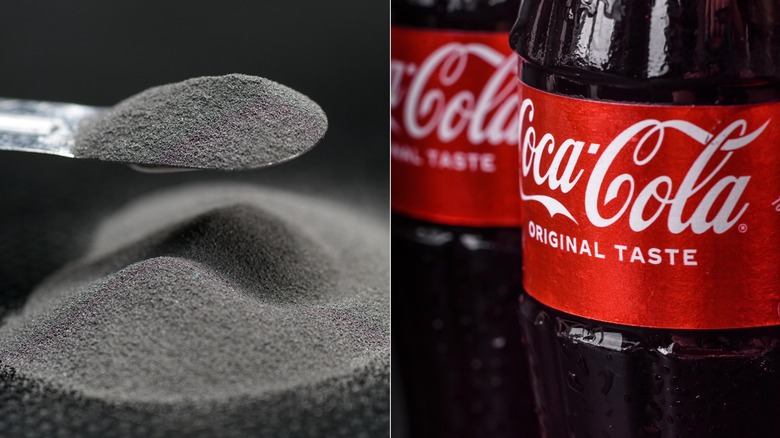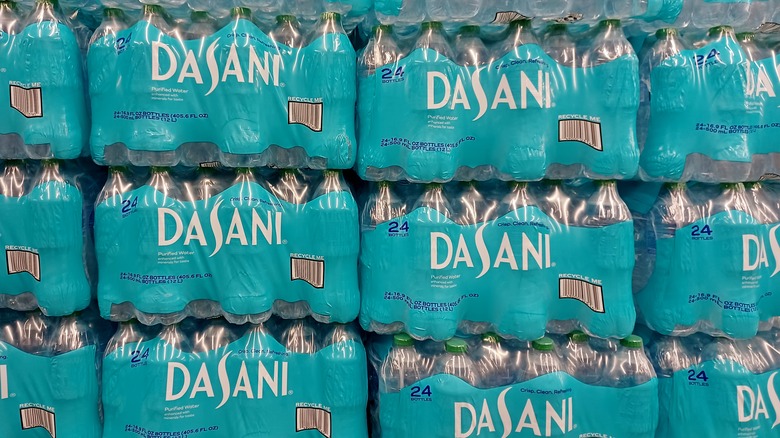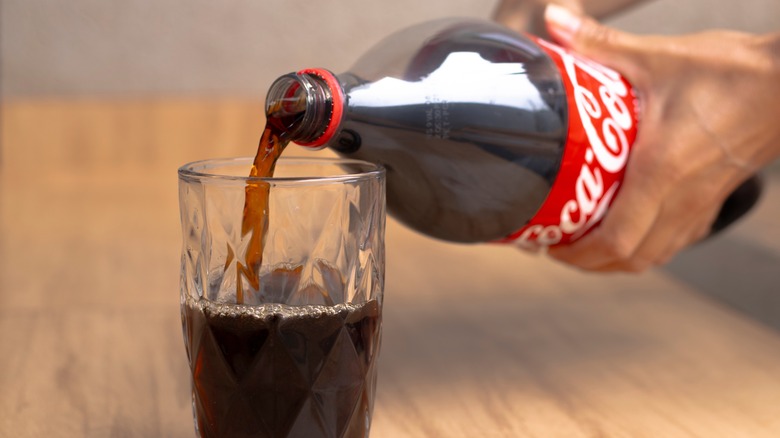The Biggest Coca-Cola Recalls Cost The Popular Company A Ton Of Money
If an item you purchased from the grocery store has shown up on a recall list this year, your experience isn't unusual. Each year, in the U.S. alone, according to Food Safety magazine, there's an average of 614 recalls of food and beverage items. Whether the recalls are voluntary and initiated by the product's manufacturer or the recalls are ordered by the federal government, they cost money, lots of money. Even small recalls are estimated by independent sources to cost companies millions.
Unfortunately, the public rarely learns the specific dollar amount of a recall. Companies don't tend release these figures. Instead, they skillfully hide the cost among categories found on a typical company balance sheet. Some of the cost will be added to one or more of the liability entries. Similarly, the company will likely fold some of the costs into one of its expense entries. A third location to discretely place evidence of a recall is under inventory. This can happen if the unsafe products sitting in the company's warehouses are destroyed. Coca-Cola understands the true cost of recalls better than most large corporations, as product mishaps have hurt everything from its bottom line to its public image over the years.
Using public information about a 1999 Coke recall where the company did speak openly about its recall expenses can shed light on the possible costs of the company's other recalls. Comparison with the recalls of other companies helps shed light on the financial impact the recalls may have had on Coke. The 1999 recall gets first attention, followed by other notable recalls in reverse chronological order.
1999 Europe
A combination of quality control issues in Europe led to a massive recall of approximately 17 million units of Coca-Cola in 1999, per the Wall Street Journal. The beverage manufacturer initially estimated that the recall would cost it $28 million, with costs shared with the bottling companies involved. Later estimates from Aon Research found the overall cost of the recall was in excess of $100 million. When adjusted for inflation, that $100 million in July 1999 would be nearly double that amount in July 2025.
The company reported that workers at its factory in Antwerp, Belgium made a mistake during the carbonation process that spoiled the taste of the drink. According to Coca-Cola, an incorrect application of carbon dioxide was at fault. There are various forms and grades of carbon dioxide. Carbon dioxide used in beverage production has to undergo a thorough purification process. Typically, the carbon dioxide is captured as a by-product from the processes taking place in petrochemical plants. The purification step makes the gas safe for use in food products. Another form of carbon dioxide is captured during fermentation at breweries. Both the carbon dioxide from petrochemical plants and that from breweries can contain hydrogen sulfide, which carries a rotten egg smell, and must be detected before the hydrogen sulfide can make it into the beverage. Belgium had over 100 customers reporting various symptoms, including headaches and stomach problems. Belgium was just one of six European nations that took steps to block the sale of Coca-Cola products.
2025: Units recalled in Texas over concern of possible metal contamination
A fear of metal contamination caused Coca-Cola to recall over 4,000 cans of Coke products from the shelves of Texas retailers in October 2025, according to the Food and Drug Administration. The items removed from stores were Coke, Coke Zero, and Sprite. The company initiated the recall after concerns arose over the possible presence of small bits of metal in the soft drink.
Back in 2017, business insurer Allianz Global stated to Food Navigator that the average cost of an insurance claim when a client experiences a significant recall in the food and beverage sector was $9.5 million. Metal contamination, as in the Texas incident, was one of the leading causes. Even modest recalls can have larger impacts than it would at first appear. For example, faulty machinery needs to be repaired or replaced. In some cases, Coca-Cola may need to find a new regional bottler if the present bottler is incapable of meeting necessary safety protocols consistently. All these precautions require disruptions to normal workday routines, resulting in an increase in production costs.
2025: A positive test for dangerous amounts of chlorate
In Europe, Coca-Cola began 2025 by recalling cans and bottles contaminated with high levels of chlorate, according to The Guardian. The company refused to give a more exacting estimate for the total number of items recalled. The discovery of the contamination took place only after the drinks had been on retailer shelves for months, with much of it being sold. Specific drinks in the recall include Coke, Sprite, Fanta, Minute Maid products, and Tropico beverages.
The food and drink industry doesn't use chlorate as a standalone item. It appears as an offshoot of chlorine-based products that manufacturers use to purify water and disinfect processing equipment. It's not uncommon for beverage companies to use water in their production processes that tests positive for the presence of chlorate. The problem is when there's too much chlorate present, as was the case with the Coca-Cola products. Coca-Cola had to collect recalled cans and bottles from the U.K. and across western Europe, including Belgium, France, Germany, the Netherlands, and Luxembourg.
2024: Metal fragments caused the recall of 28 million bottles
In 2024, Coca-Cola was responsible for one of the largest recalls in the history of Austria after it became necessary to remove around 28 million plastic bottles of soft drink from the market due to the possible presence of metal fragments, per Euronews. A metal sieve malfunctioned in a production facility responsible for half-liter bottles. By law, the affected bottles weren't reusable. They had to be destroyed, adding to the financial impact of the episode. The specific drinks involved were Coca-Cola, Sprite, Fanta, and Mezzo Mix. Mezzo Mix is specific to Germany and Germanic-heritage areas within Austria, Switzerland, and Finland. It's a combination of Coca-Cola and an orange-flavored soft drink that became popular in the former West Germany in the early 1970s.
The recall was initially limited to Austria, but soon fears grew that damaged bottles may have entered the German market, forcing the recall to expand. In time, those fears were confirmed. The severity of the recall can be seen in the way it removed a cultural favorite in Mezzo Mix from its key demographic. The damage is also evident in the way the recall expanded beyond the borders of Austria. Regional production facilities in Europe are always at risk of this sort of multi-country impact. Inside Beer reported that the company was already weathering bad times, moving backward 1% in revenue for the year's third quarter. Earnings per share year-over-year were down by 7% while operating margins fell by over 6%.
2024: Mislabeled Miinute Maid requires the recall of 13,000 packs
In 2024, CNN reported that a labeling mistake resulted in the recall of more than 13,000 cases of 12-packs of Minute Maid Lemonade produced by Coca-Cola and distributed in Kentucky, Ohio, and Indiana. The mislabeled items were the regular lemonade that contained a standard amount of sugar. However, they were mistakenly labeled as Minute Maid Zero Sugar Lemonade. The disparity in the sugar contents between the two items meant the mislabeling posed a possible health threat to someone needing to closely monitor their blood sugar. According to its label, the regular lemonade contains 40 grams of sugar per 12-ounce can.
Mislabeling leaves a company vulnerable to litigation. Even when the labeling is a genuine mistake and not a deliberate attempt to mislead the public, it's a violation of U.S. food safety laws and is considered misbranding. Personal injury lawsuits could result from the consumption of a regular lemonade from someone well-documented as a diabetic, for example. There could also be a class-action lawsuit from consumers not put at risk by consuming the sugary drink, but who still want compensation for purchasing something they didn't intend to purchase.
2023: Foreign materials led to 2,000 cases being recalled
In late 2023, Coca-Cola recalled 2,000 cases of 12-packs of its popular soft drinks, according to USAToday. The recall of mostly Sprite focused on the three southern states of Alabama, Mississippi, and Florida. Also included in the recall were Diet Coke and Fanta. The company didn't specify which objects may have triggered the recall, but simply mentioned the possible presence of foreign material. During food and beverage production, foreign material can sometimes refer to shavings or bits of equipment that enter the beverage. Often, the material is metal or rubber. Sometimes the foreign material can also be insect-related.
When foreign materials are found in a beverage, it's necessary for the manufacturer to remove those bottles or cans from the market as fast as possible. But more than the public safety is at stake. The longer the items remain available for consumer purchase, the greater the likelihood the company will be named in a lawsuit that could produce a huge settlement. Even a relatively small recall can place a company in the crosshairs of a law firm. For example, in 2024, five people shared a $130 million judgment in Nevada against the bottled water company Real Water after suffering liver damage caused by contamination, according to an Associated Press report.
2021: Over 7,000 cases of Minute Maid Lemonade were recalled for possible metal contamination
In 2021, Coca-Cola had to recall three Minute Maid Lemonade flavors in eight states due to the possibility of metal contamination by the presence of bolts and washers, per FDA data. The company pulled close to 7,500 cases of its products from Pennsylvania and states along the east coast, including Maine, Connecticut, New Jersey, New York, Maryland, Virginia, and North Carolina.
It's one thing for a beverage manufacturer to issue a recall due to metal shavings, but it's a totally different story when the beverage is contaminated by entire bolts and washers. The latter indicates mechanical failure. Some of the large-scale equipment used in beverage manufacturing is designed to experience heavy vibration, which over time can cause bolts and washers to wiggle loose. If there's no safety procedure in place for the possible contingency of the metal fasteners becoming loose, there's the possibility of them entering the beverages, as happened with PepsiCo and its Starbucks drinks, as reported by SCNR. The company will then have to halt production and make repairs, possibly installing upgrades and safety guards. None of these improvements is inexpensive.
2006: An extortion attempt forced the company to recall around 40,000 cases
Coca-Cola had to recall in South Korea tens of thousands of cases of Coke products in 2006 after someone was apparently poisoned by one of the company's products, according to Voice of America. A police investigation found three contaminated bottles, leading to the recall of 40,000 cases. But the root cause turned out to be a financial crime. Further investigation led to an arrest and the uncovering of a criminal attempt to extort money from the soft drink giant, per Beverage Daily.
You can get a rough idea of how costly the recall was by examining a similar incident that happened to rival soft drink maker Pepsi. In 1993, a Washington state couple claimed to find a syringe in their can of Pepsi, according to Newsweek. Quickly, the couple conferred with a lawyer and took their story to the media. Soon, there were syringe sightings popping up across the country. The case finally took a turn in Pepsi's direction after surveillance tape at a Colorado grocery store revealed a customer placing a syringe in a Pepsi product. Nationwide, there were numerous arrests for hoaxes and false complaints.
Interestingly, throughout the crisis, Pepsi never issued a recall. But the hoax still cost the company an estimated $25 million in just two weeks. To entice customers back to Pepsi, the company later offered a huge $10 million discount program, bringing the total to somewhere around $35 million. Adjusted for inflation, in 2006, the time of the Coke extortion attempt, that $35 million would have been more than $49,300,000.
2006: Bottles were withdrawn from the Japanese market for fear of iron powder
Japan was the site of a recall of 2.4 million bottles of Coke products in 2006, suspected of containing iron powder, according to The Japan Times. The recall covered 13 distinct areas of Japan. Foul play was never considered. Instead, officials suspected the contamination was the result of a malfunction of a standard piece of equipment during an otherwise normal production run. Correcting the problem may have included an equipment overhaul, reevaluation of the production process, retraining workers, and revamping the quality control protocol. All these steps would adversely affect the company's bottom line.
Accidents of this sort are expected in the food and beverage industry. However, these mistakes are treated differently according to the culture of the consumer. According to PubMed, a survey revealed that the Japanese consumer has a higher than average concern for food safety. Once a trust is violated by a recall, it could take much effort over a long time to regain that trust. That time and effort means spending perhaps million of dollars on marketing campaigns to reassure a nervous public.
2004: Dasani water recalled for high amounts of bromate
Coca-Cola's Dasani water brand was the focus of a 2004 recall in the U.K. involving 500,000 bottles after the water tested positive for high amounts of bromate, according to CNN. In some cases, the level detected was more than twice the legal limit in the U.K. Small amounts of bromate are acceptable since bromate naturally occurs during the disinfecting stage when water's bromide interacts with ozone. However, large exposure to the chemical is especially unsuitable for young women and children. Typical symptoms involve gastrointestinal issues, such as nausea. New York State's Department of Health explained that massive exposure has triggered the growth of cancerous cells in laboratory rats, but it's still unknown if similar results could occur in humans, necessitating cancer screenings.
Prior to the recall, the U.K. market was already showing signs of resistance to Dasani because Coca-Cola's water wasn't taken from a natural spring. Bottled water isn't a huge priority in some parts of the world due to the ready availability of free, clean tap water. The recall, a public relations fiasco for Coca-Cola, was too much to overcome, contributing to the company deciding to completely withdraw its Dasani brand from the U.K.
1972: Solvent drives recall of 3 million cases
Equipment failure left a bad smell in cans of Coca-Cola, resulting in the 1972 recall of 3.2 million cans distributed in the state of New York, per the New York Times. When a production oven failed, a solvent used to prep the interior of soft drink cans didn't burn off as expected. Enough remained to make the soft drink smell like a petroleum product.
Coca-Cola's situation was similar to what would later befall another food giant, Kellogg's, in 2010. As reported by Food Manufacturing, the cereal manufacturer pulled 28 million boxes of its products because an inner lining was giving the cereal an unpleasant smell. The company destroyed its stock of wax material that was causing the problem. As was the case with Coca-Cola's recall, there were no records of serious illness resulting from consumers using the products. However, the incident was a financial gut punch for the cereal maker, pulling its stock price down by 0.8%. Kellogg's misfortune is an example of how even a well-managed recall without a serious health risk can negatively impact a global powerhouse like Coca-Cola, even though the actual costs are never made public.

